Group F of this year’s FIFA Women’s World Cup has seen its first matches played; so far, just one of the four teams in the group has scored. That team is Brazil, who breezed past Panama with a 4-0 victory. The other fixture in the group was France vs Jamaica, which, despite the French dominating possession and both sides landing some efforts on goal, this game ended goalless.
This tactical analysis will look at Jamaica’s defensive tactics – how they were able to shut France out, along with a look at how they reacted when they did have moments of possession. The analysis will also include a discussion about Jamaica captain (and Manchester City star) Khadija Shaw, who received a red card late in the game — we will look at her influence on the side and just how much her side may miss her in the next game. At the same time, she is suspended, as well as who might replace her.
Lineups
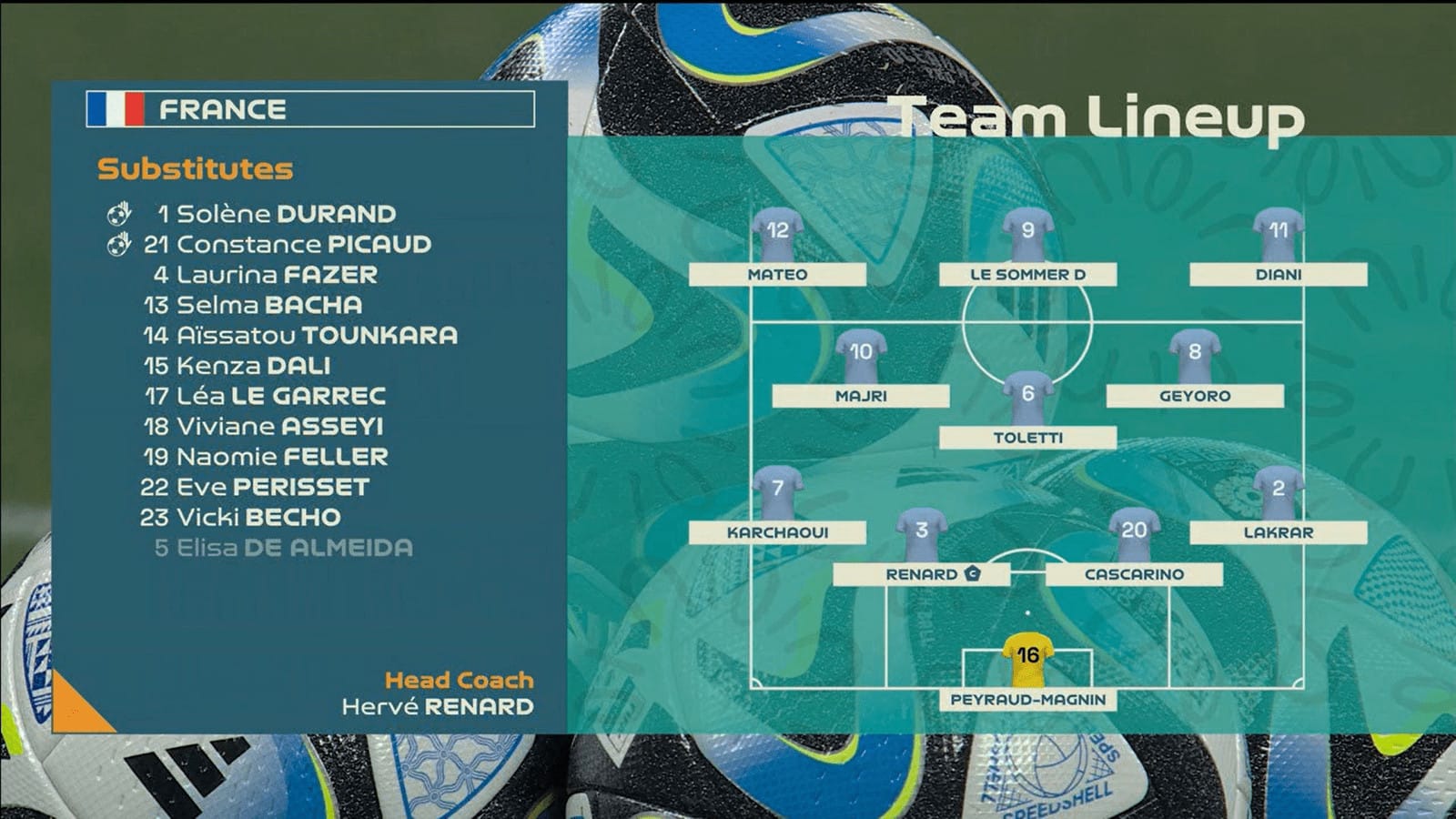
Match favourites France deployed a 4-3-3 shape that looked to stretch the pitch, meaning wingers Clara Matéo and PSG’s Kadidiatou Diani had essential roles to play in possession, as did full-backs Sakina Karchaoui and Maëlle Lakrar. Eugenie Le Sommer, France’s leading all-time goalscorer (89 goals), led the line, with midfield support coming from Amel Majri (Lyon) and Grace Geyoro (PSG). Skipper Wendie Renard was partnered at the back with Estelle Cascarino.
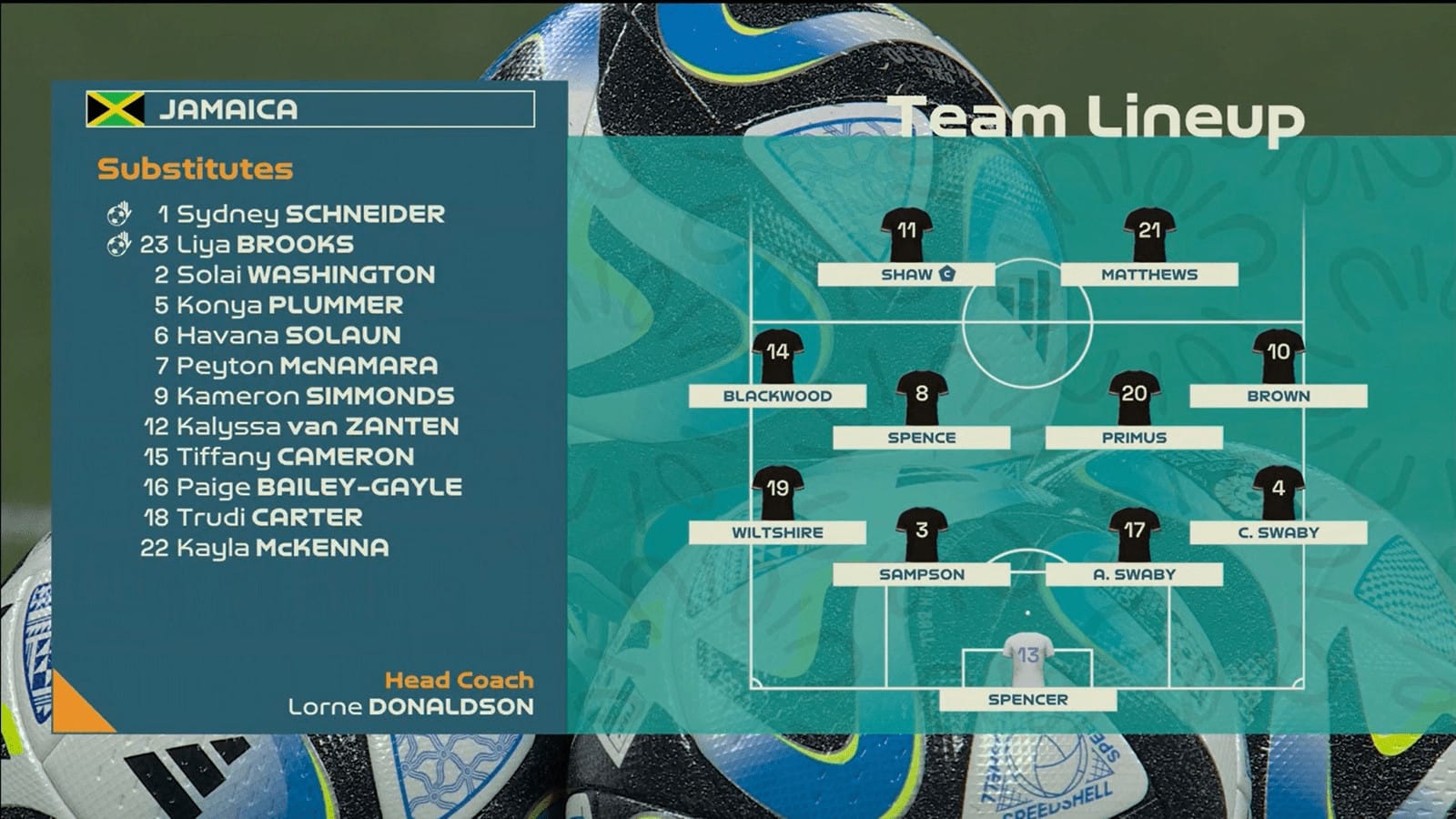
A classic 4-4-2 shape was deemed the best way to go by head coach Lorne Donaldson. Captain and UEFA Champions League star Khadija Shaw started the game on the left side of a strike partnership with Cheyna Matthews. In midfield, the width was provided by Deneisha Blackwood and Jody Brown (the former can also play in defence, while the latter can play in a more attacking role, too.). Atlanta Primus of London City Lionesses lined up in central midfield next to Spurs playmaker Drew Spence. However, both women had more defensive involvement than attacking in this fixture due to France’s grip on possession.
Jamaica in possession – understanding the assignment
As our very own Bryant Marques reported in his World Cup preview of Jamaica, this team likes to play with pace and directness, which suits them in games like this, where they have limited time on the ball. Often when a team is forced to play most of the game without the ball, they look somewhat struggled and clueless when they do get the chance to attack, but Jamaica showed that they are prepared for this scenario with their performance. That’s not to say France were against the ropes or under any real pressure, but Jamaica did display a clear tactical identity.
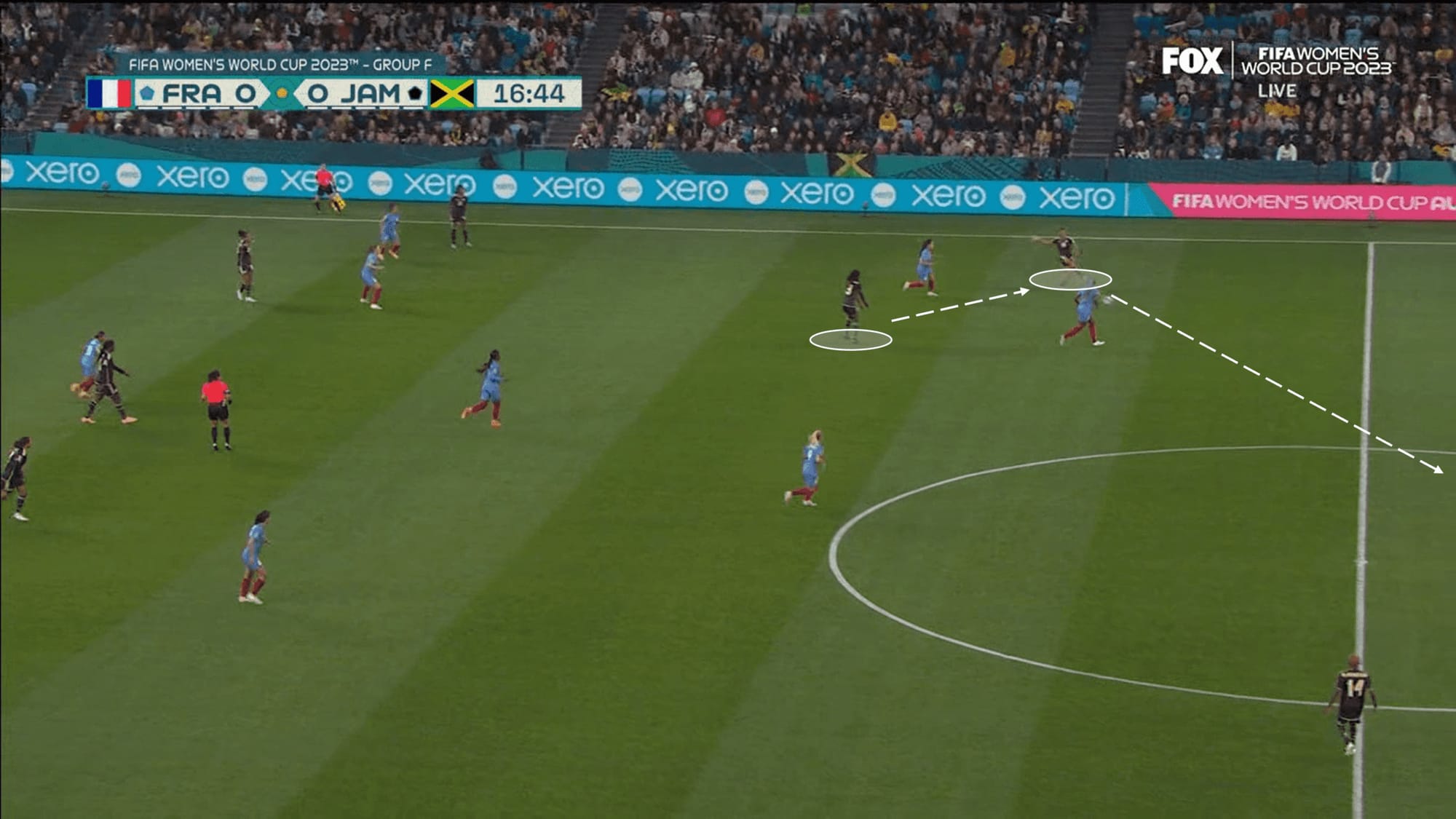
Again, going back to Bryant’s tactical preview on Jamaica, we know they like to bounce passes in deeper areas using their CBs and CMs, but they also transfer those elements into their general play to work the ball into space, as they did above. Continuing with that theme, they like to get the ball wide when the chance presents itself — this move came after the initial pass back to the deeper defender.
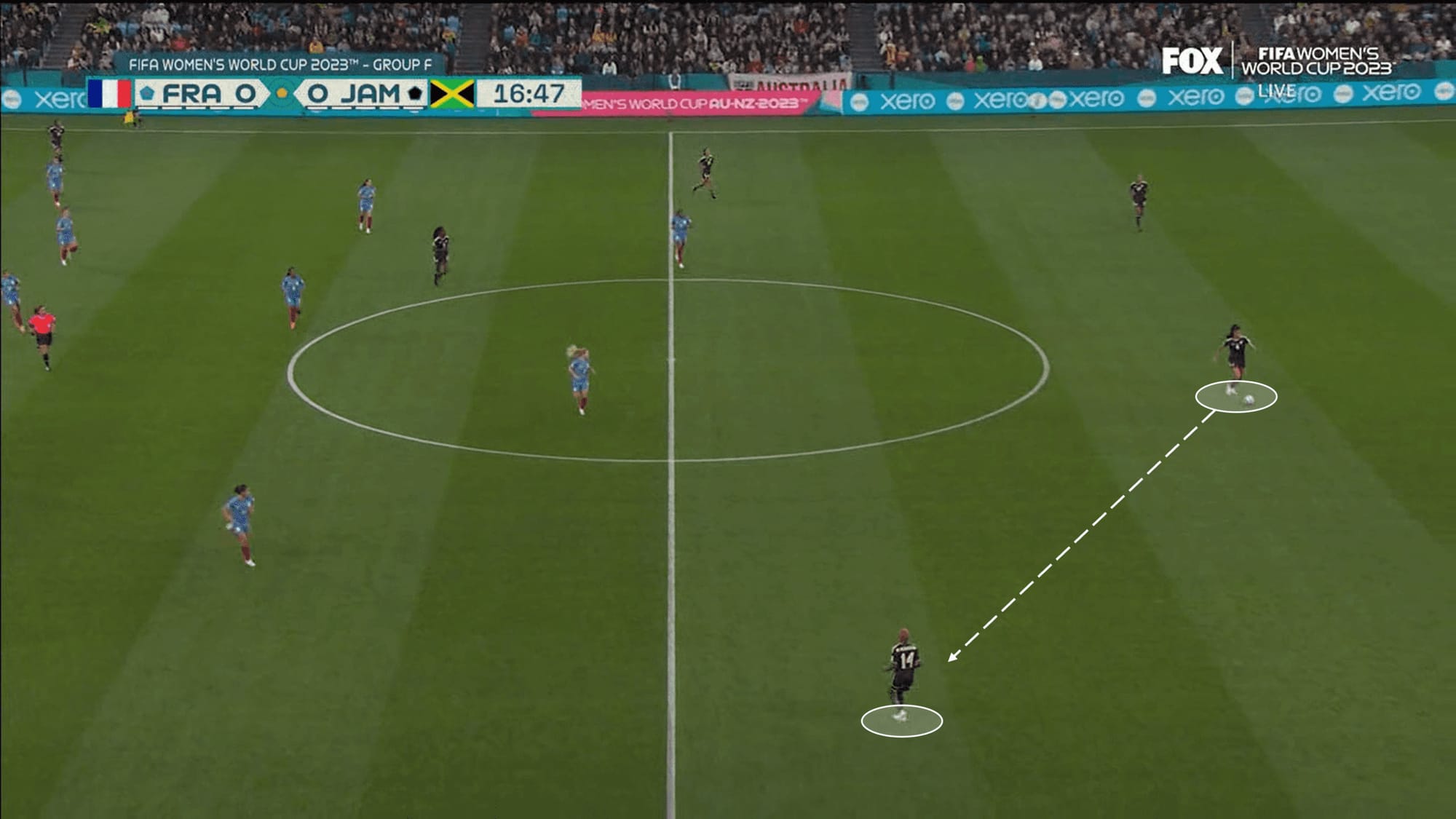
They showed no hesitation in carrying out that pass to a wider player, and as Bryant touched upon, their FBs like to remain deeper as this allows Jamaica to play more switch passes — another tendency within their tactics. In the image above, midfielder Blackwood dropped into this deeper role, but she is not the one who delivered the cross-field pass – notice the lack of space her teammate has on the opposite flank; they had to draw France out a little and create space by stretching the pitch. Blackwood did this by initially taking the ball wide toward the touchline before returning the ball to her CB teammate.
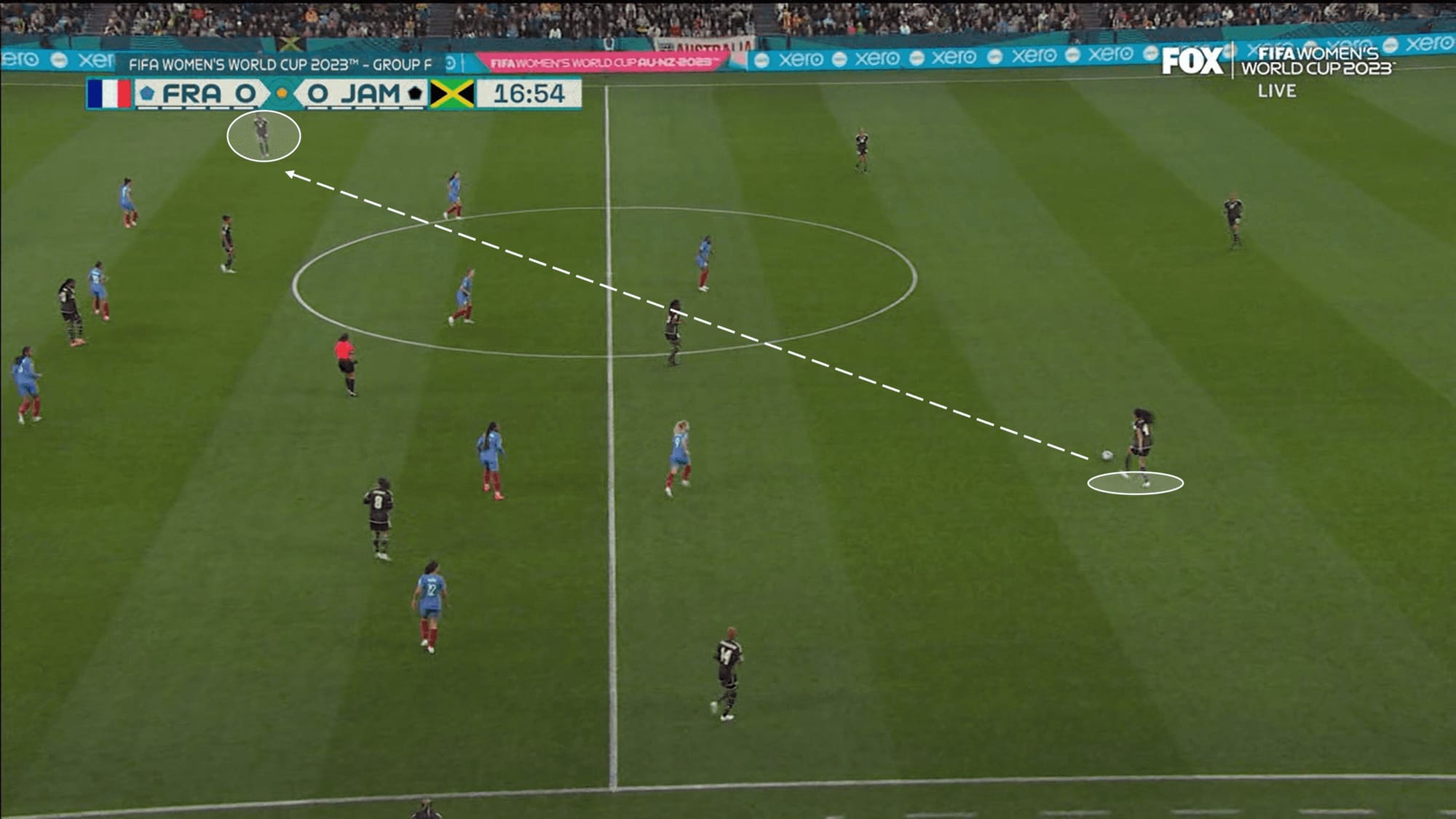
LCB Vyan Sampson recollected the ball from Blackwood, and Jamaica had successfully drawn France out enough to create that space on the opposite flank. With no reluctance, Sampson executed a perfectly weighted pass to Brown, allowing Jamaica to launch an attack down the right flank.
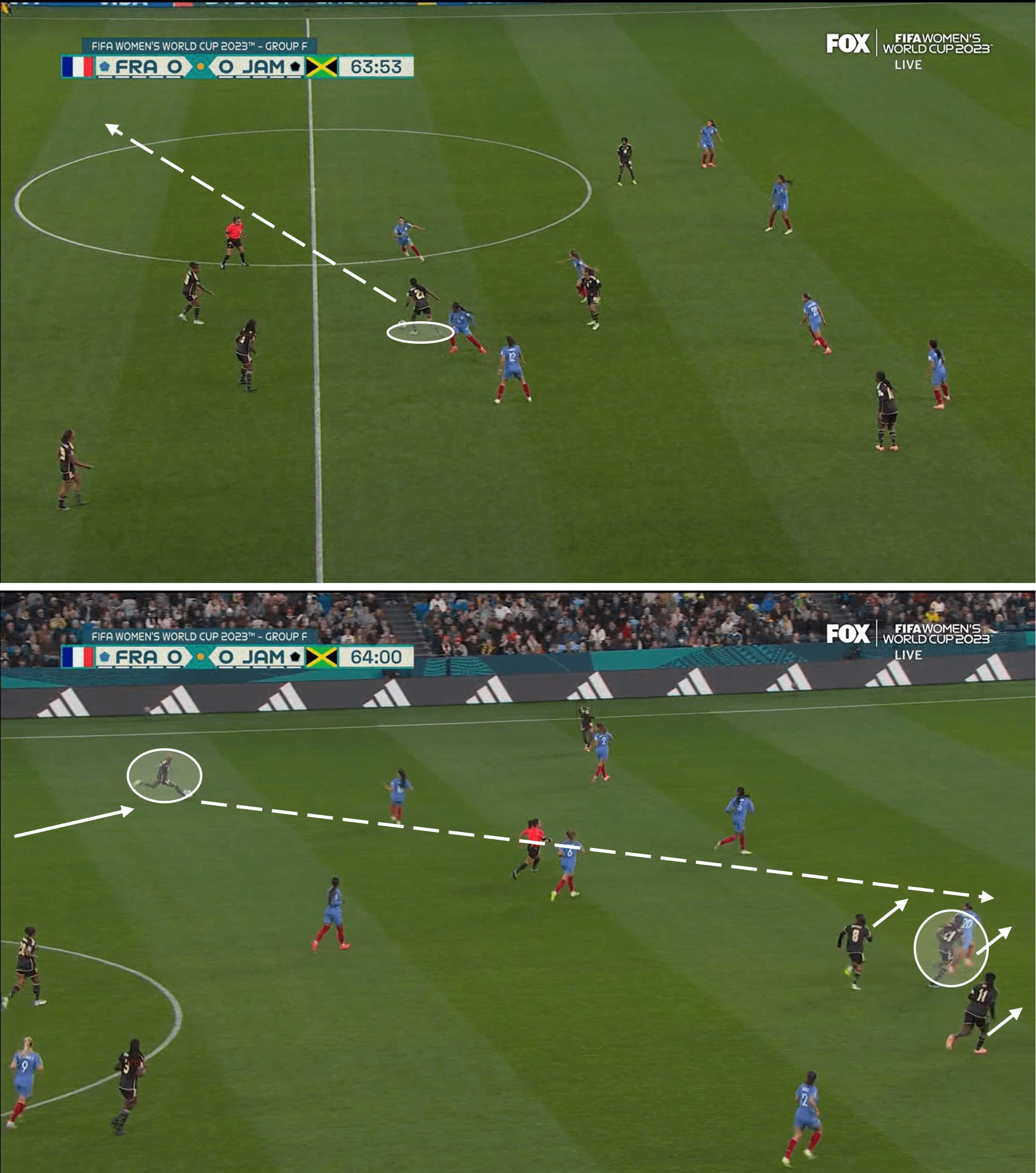
Direct play is an integral part of Jamaica’s play, often looking to play passes into spaces/behind defences when possible. This was present against France, and the example above demonstrated their tactical understanding across the pitch and their threat in fast attacking moments.
The move started after Jamaica won the battle for possession in midfield, with the ball immediately being released into the path of Tiernny Wiltshire, who sustained this attacking momentum with a big first touch, taking her into the opposition’s half.
With little close support but three attacking off-the-ball runs being made in a more central area, she opted for that pass we spoke of before — the lofted one in behind the defence. Cheyna Matthews was the player to meet the long pass but couldn’t generate enough power to cause France’s keeper any real issues.
How Jamaica kept the French at bay
France registered 72% possession in this tie, which sheds some light onto the type of game Jamaica had to play. However, don’t be lulled into assuming that Jamaica parked the bus for 90 minutes, as this was not the case. They showed good individual and unit ability to shut France out, who only mustered two clear-cut opportunities from a total of 14 efforts on goal.
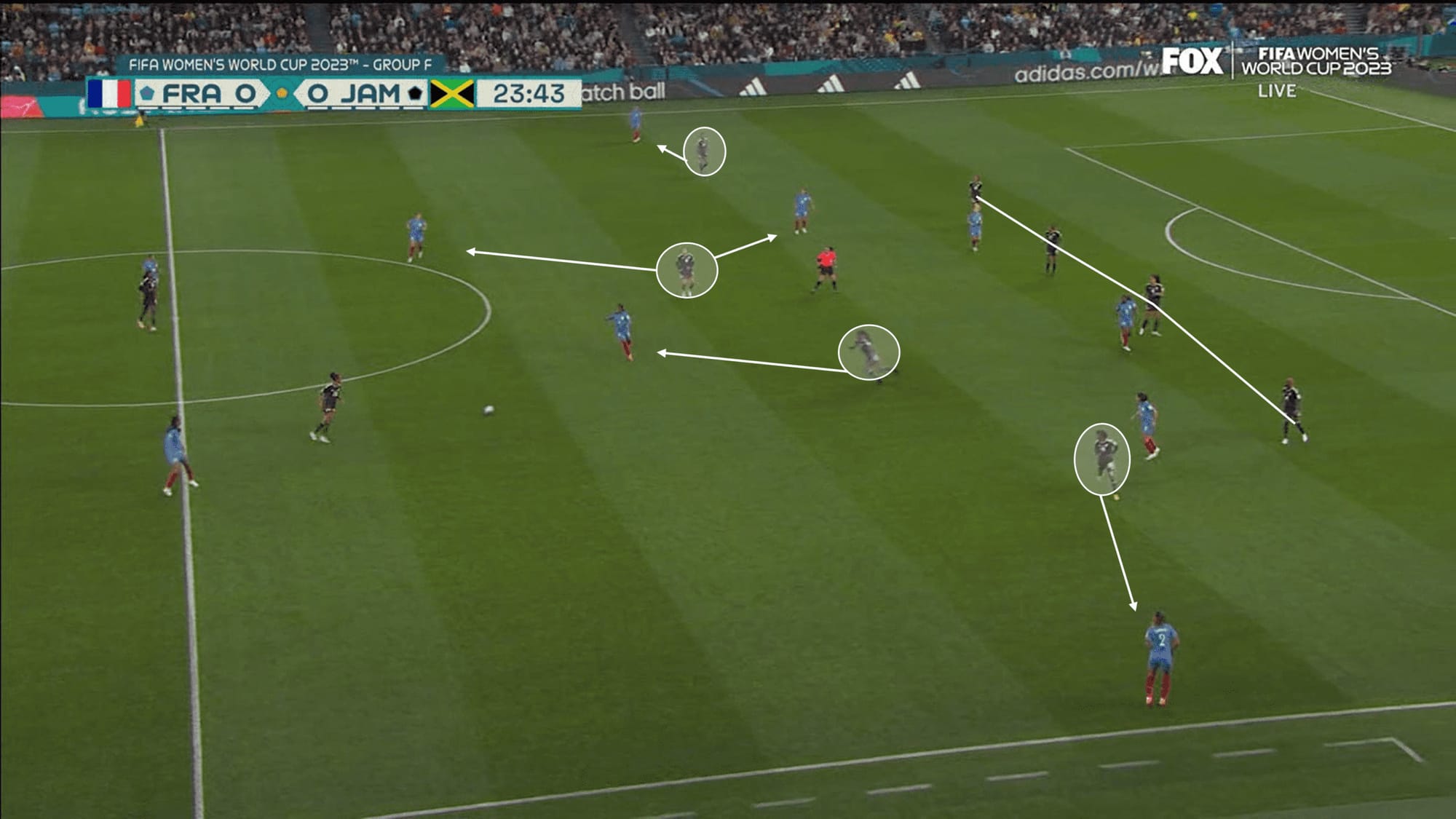
This example gives us some insight into how Jamaica set themselves up off the ball against France. The back four preferred to remain compact, with wide defensive support being provided by the wingers. This meant the midfield unit did not share the same narrow traits as the defensive unit but did give them a chance to mark player-to-player and quickly close down several passing options when needed. France found it hard to put together passing sequences in higher areas, partly due to this nice balance in width between the two Jamaica units.
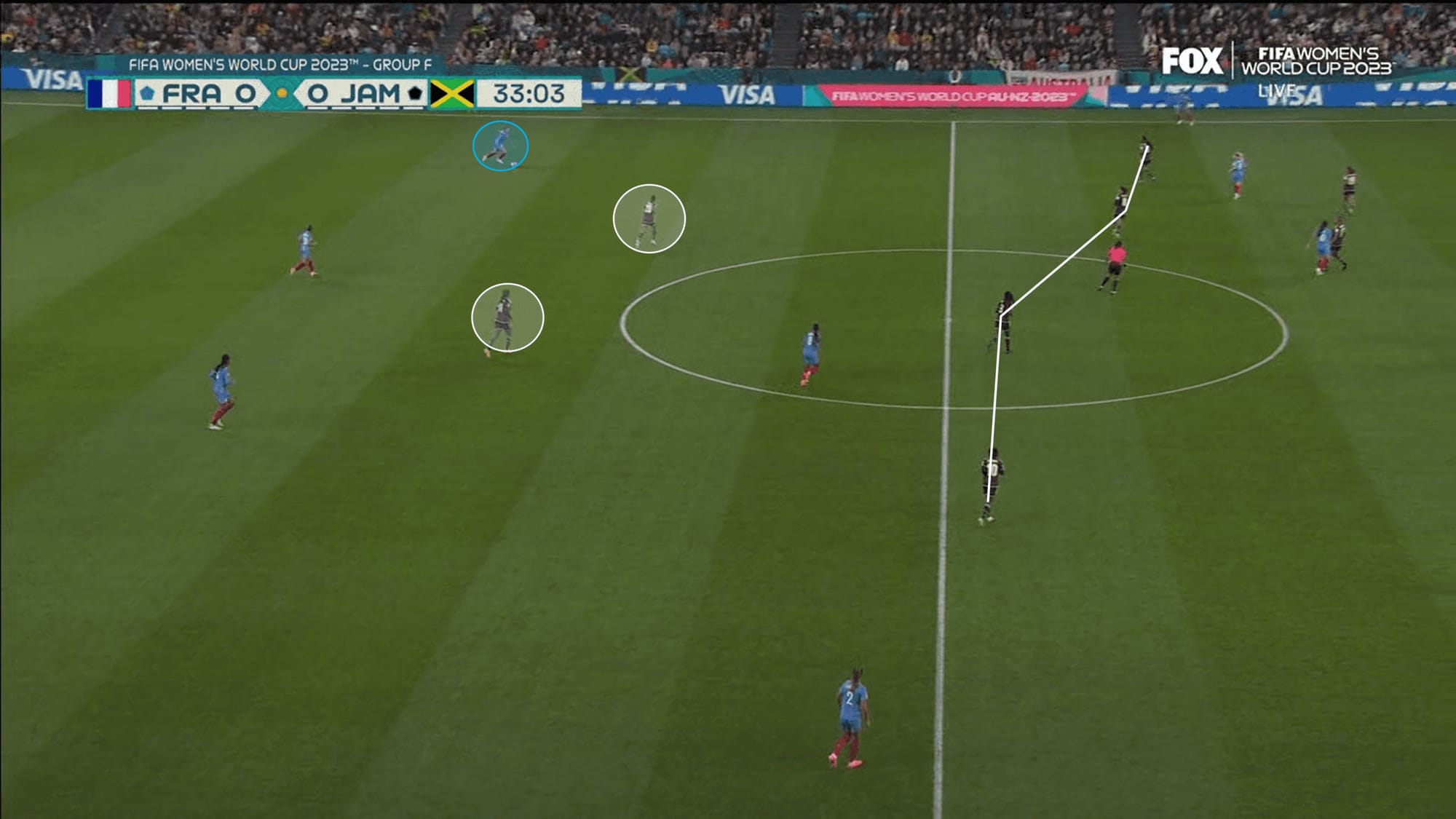
When France had the ball in their own half, Jamaica’s front two applied minimal pressure to the CBs, instead simply occupying nearby space to encourage France to speed things up. When the ball was in these kinds of areas, Jamaica’s midfield unit didn’t yet need to be as wide as when possession is higher up the pitch. Instead, they set up zonally, waiting for the moment to inject intensity and aggression into their approach.
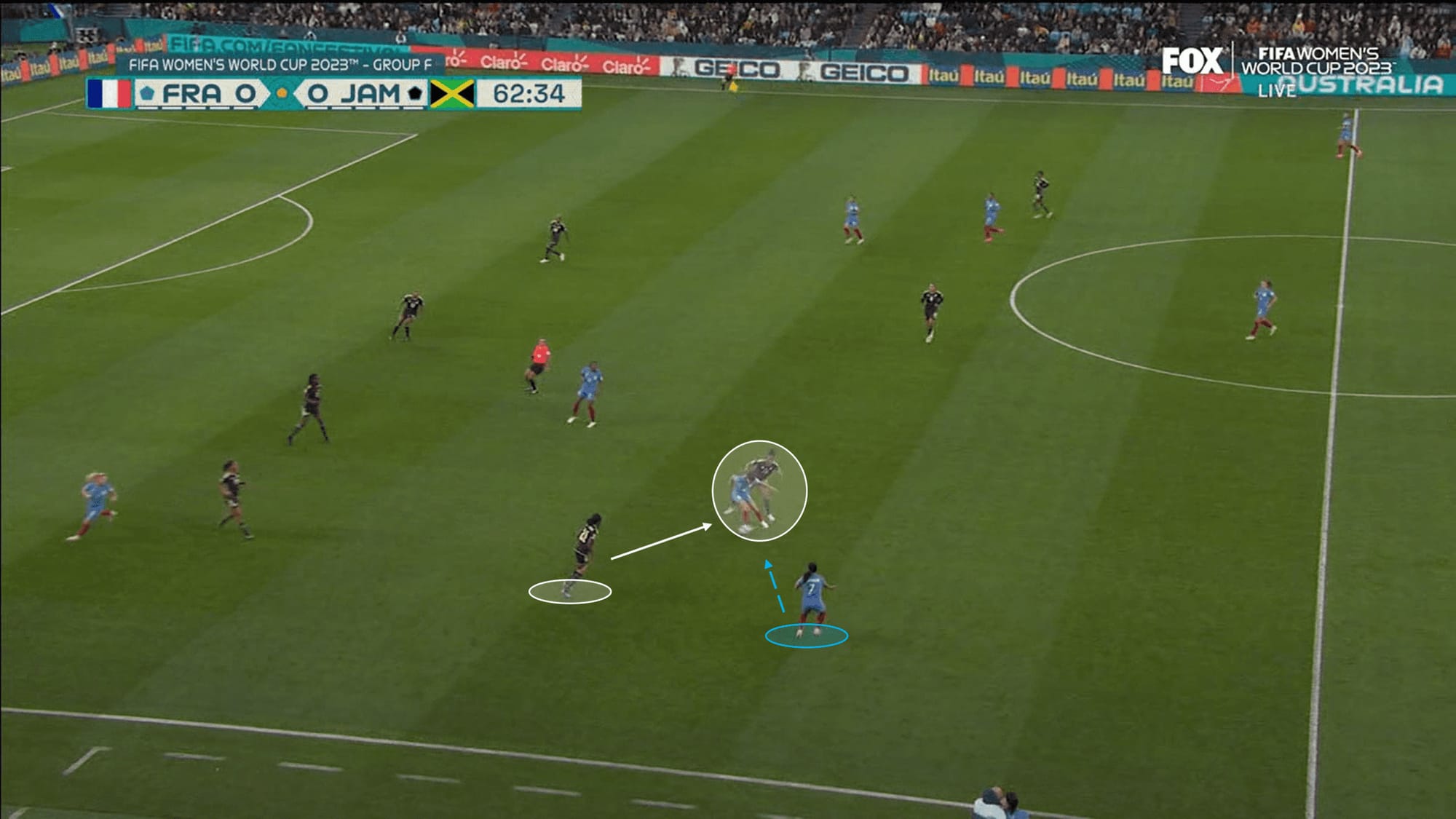
Here is an example of that intensity and aggression. France were allowed to play their pass into midfield. Still, the blue shirt was met by Jamaican force immediately, with the second arriving player, Jody Brown, stealing the ball away from her French counterpart, stopping France’s possession phase and giving her side a chance to launch an attack of their own.
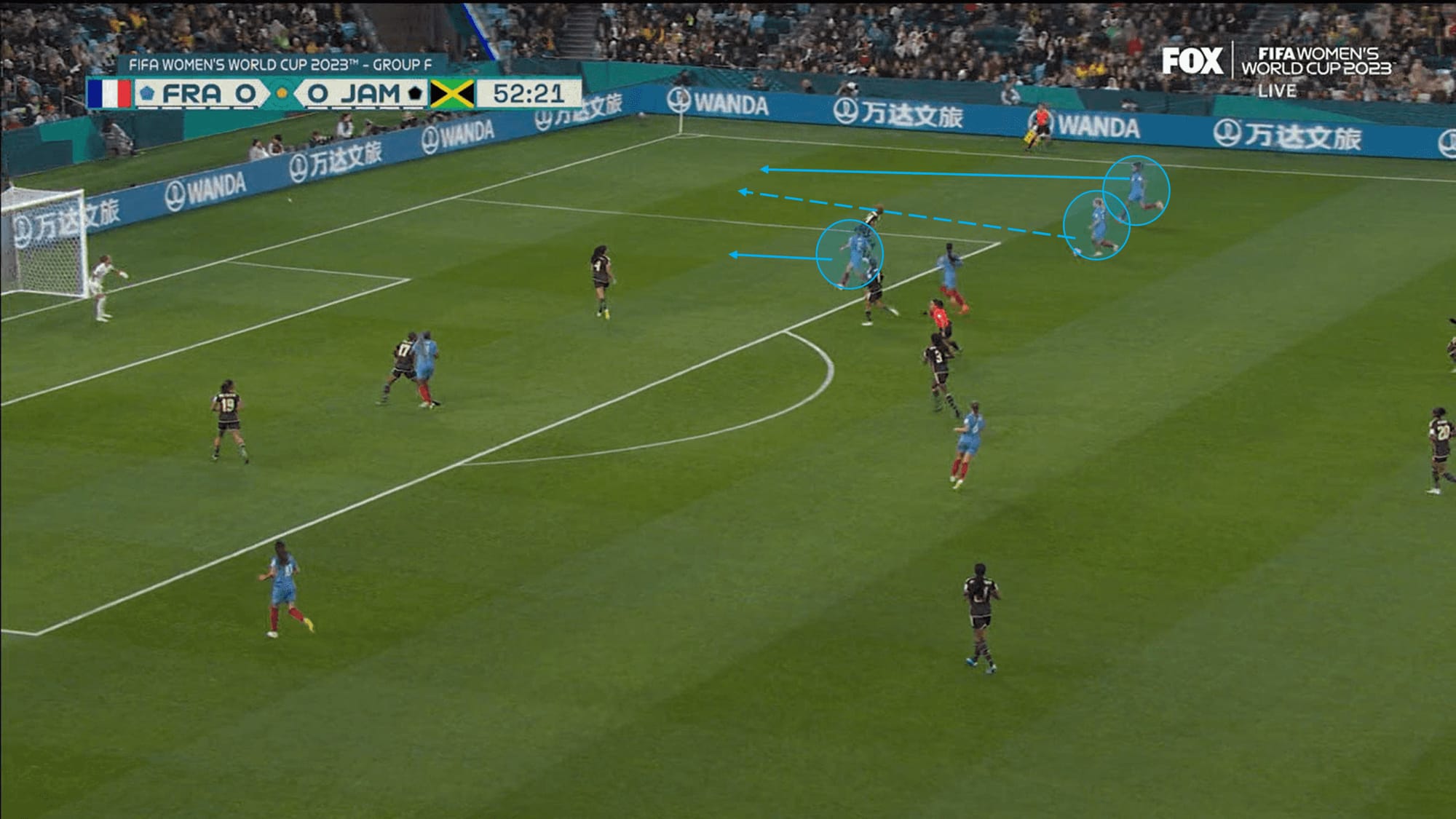
Allowing your midfielders to defend with such intensity can be effective, and it was a lot of the time against France, but there were also times when it only created space that the French could exploit, and the above analysis shows this. They were able to break down the right flank with a significant numerical advantage, with the pass being played into space for Diani wide on that flank. She received the ball close to the byline, but like many of France’s play on the day, the delivery lacked quality in the vital moment.
How do Jamaica cope without Shaw?
Khadija Shaw is Jamaica’s talismanic striker. Currently playing her trade for Manchester City, Shaw scored twice in Jamaica’s CONCACAF qualification group (four games long). Still, her contribution to her national side is more than just her goals – her physical ability and strong positional awareness are key attributes that enable her to effectively build up play, linking up nicely with the midfield unit, for example.
We will talk about what other qualities she has that make her so crucial for Jamaica and why her side will miss her presence before looking at other options in the squad that could be brought into play for the game against Panama.
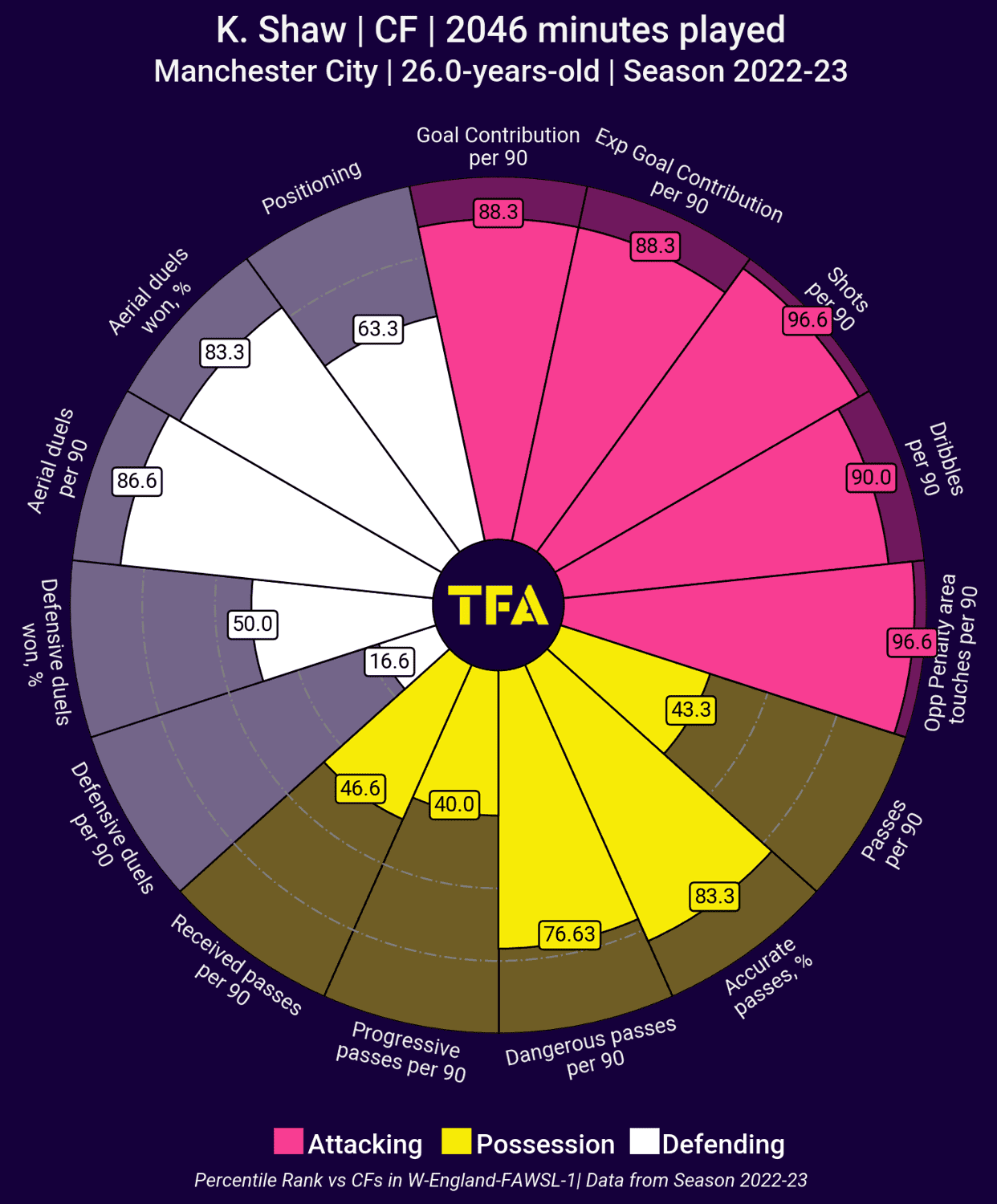
Sticking with the previous point about Shaw being critical in other areas aside from goalscoring, her data pizza above gives us an idea of exactly what she offers. Effective in some possession metrics, she has good vision and passing technique, as evidenced by her high percentile ranking for dangerous passes per 90 and overall pass accuracy. We mentioned her physicality, which she uses well in aerial duels, winning an impressive number while demonstrating her ability to intercept and steal the ball from the opposition.
With all due respect to Panama, Jamaica would prefer to have Shaw suspended against them rather than against Brazil. Still, boss Donaldson insists that her suspension is a massive blow for his side, and he is correct — Shaw’s presence in build-up phases and in the attacking third will be missed, but time will tell as to how much.
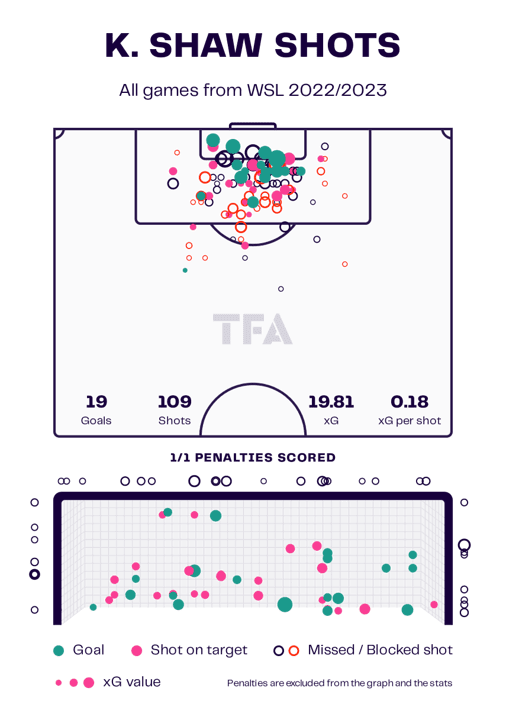
Shaw’s xG map from last season for Manchester City gives us a clearer idea of how deadly she is in front of goal. With 19 non-penalty goals to her name last season, her xG map paints the picture of a clinical striker in the box who should not be afforded any time or space.
She also has a long shot in the locker, scoring from range for City last season — she also achieved this feat in Jamaica’s world cup qualifying campaign. Her various high percentile ranks in the attacking department in the pizza above also tell us how important a player she is for both City and Jamaica.
So, who steps up for Donaldson’s side? They have several options at their disposal. Kameron Simmonds of the Tennessee Volunteers is an option, with the 19-year-old tipped to have a bright future for Jamaica, while Kiki Van Zanten could also make the step up – she has 21 goals in 75 appearances for her club Notre Dame Fighting Irish, and also has one in six for Jamaica.
Rangers forward Kayla Mckenna is in her prime years as a player at 26 years old, so that Donaldson may opt for her, but if he wants to experience in his attacking ranks, then expect to see 31-year-old Tiffany Cameron, who is currently a free agent. She has five goals in 12 games for Jamaica and has played in a variety of leagues around Europe, so she has to be the favourite to partner Chenya Matthews up top, assuming Jamaica stick with the 4-4-2.
Conclusion
A fantastic result for Jamaica, and a historic one, too — their first-ever point in a World Cup group stage. But they don’t want to stop there. If they turn this positive result into momentum for their game against Panama, they could go on to collect their first-ever win at a World Cup, with or without Shaw. France will be disappointed. In a game that most expected would be a breeze for the French, they were underwhelming in their play and will expect much better of themselves when they face Brazil.






Comments